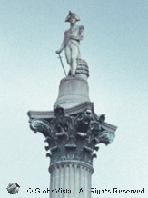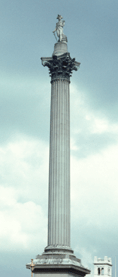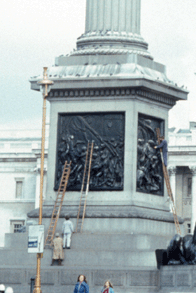Nelson’s Column

Public Art: Nelson’s Column
Architect: The column was designed by William Railton
Sculptors: © E. H. Baily (Horatio Nelson statue) and Sir Edwin Landseer (4 lions)
Date Unveiled: October 27th, 1834.

Description: The 5.5 m (18 ft) sandstone statue of Horatio Nelson stands atop a 46 m (151 ft) Corinthian column. The statue faces south, looking towards the Admiralty and Portsmouth where Nelson’s and the Royal Navy Flagship HMS Victory is docked. Admiral Horatio Nelson is wearing his full naval uniform and in his left hand rests his sword. The sword is an important symbol for Lord Nelson who vowed after losing his right arm at Santa Cruz never to part with it (it had originally belonged to his uncle, Captain Maurice Suckling).
The granite Corinthian column was inspired by the temple of Mars Ultor in Rome. The top of the column is decorated with bronze acanthus leaves which were cast in the Arsenal foundry at Woolwich from British artillery (cannon).
The square pedestal is decorated with four bronze reliefs, cast from captured French guns, depicting Nelson’s four great victories. Parts of the relief protrude out some 15 inches.
The North panel (facing the National Gallery) depicts the Battle of the Nile and was designed by William F Woodington. The scene takes place following Nelson having been severely wounded in the head and includes Captain Berry and his surgeon. The panel weighs about 2 tons.
The South Panel (facing Whitehall), depicts the “Death of Nelson at Trafalgar” and was designed by John Edward Carew. The scene takes place after Nelson was shot on the deck of the Victory and is carried by a marine and two seamen to the lower deck. The surgeon and Captain Hardy feature in the scene as do several marines and a negro sailor.
Beneath the scene is Nelson’s famous words “England expects every man will do his duty.” The figures on the relief are life size and the panel weighs about 5 tons.
The East panel (facing the Strand) depicts the Bombardment of Copenhagen and was designed by John Ternouth. In this scene, Nelson is holding his gun whilst ordering his despatch to send the flag of truce. A group of officers surround Nelson, in the foreground lay wounded men and in the background, the city of Copenhagen is burning.
The West panel (facing Pall Mall) depicts the Battle of St. Vincent and was commenced by Musgrave Watson and finished by William F Woodington. This scene shows Nelson on board the ship San Josef accepting the swords of the Spanish admirals and in the foreground, a dying sailor clasps a broken flag-staff.
The four 11ft bronze lions by Sir Edwin Landseer were added in 1867.
Location: You can find Nelson’s Column standing in Trafalgar Square, London (just follow the pigeons!).
Cost: Nelson’s Column was funded by public subscription and cost £47,000. One of the contributors to the fund was none other than Tsar Nicholas of Russia.
History Of Nelson’s Column: A monument to Lord Horatio Nelson was first proposed in 1805 following his death at the Battle of Trafalgar, however, it would take another thirty years before a subscription was raised in 1838. The Duke of Wellington recommended a column as a fitting monument and Trafalgar Square was chosen as the site. In January 1839, 118 drawings were submitted and the winning design was awarded to William Railton. The column was built between 1840-1843.
The 17ft stone statue of Horatio Nelson was carved from Cragleith stone. The three stone blocks came from the Granton quarry of the Duke of Buccleuch, in Scotland. The statue weighs nearly 18 tons. It was placed atop the column on November 3rd 1843.
The column was made from granite which came from the Foggintor quarries on Dartmoor.
Part of the interior base was made from the 29 cannon recovered from HMS Royal George, HMS Victory’s sister ship.
The four bronze lions by Sir Edwin Landseer were added to the monument in 1867. They were cast lying down because it was cheaper than casting them standing up.

Nelson’s Column Trivia: In 1925 a Scottish con artist by the name of Arthur Furguson, “sold” the landmark to an unknowing American. The American shouldn’t have felt too bad, Furguson also “sold” Big Ben and Buckingham Palace.
Hitler’s master plan, after successfully invading Britain, was to have the column dismantled and shipped to Berlin.
Nelson’s Column is a copy of the one at the temple of Mars Ultor in Rome.
The foundation stone of Nelson’s Column was laid by Charles Davidson Scott, the son of Nelson’s secretary, John Scott, who was killed when a cannonball nearly cut him in two while he was on the deck of the Victory during the battle of Trafalgar.
Before the statue of Nelson was placed on the column in 1843, 14 stonemasons who had worked on the project had a dinner party on top of the column.
The octagonal lights at each corner of Trafalgar Square are believed to be from Nelson’s flagship, Victory. In the olden days, lamplighters were given extra pay for cleaning them.
When the column was refurbished in 2006 it was discovered the column was 4.4 metres shorter than previously thought.
Lord Nelson was a short man standing just under 5ft6″. He lost sight in his right eye when a cannonball landed near his feet, sending gravel into his face during the Siege of Calvi (1794). He lost his right arm during the attack on Santa Cruz (1797). As Nelson stepped on shore and drew his sword a musket ball ripped through his right arm just above the elbow. It was amputated by the surgeon on the ship Theseus.
The real lion that Sir Edwin Landseer used as a model unexpectedly died, forcing him to work with a decaying carcass.
There is a 169ft (51.5m) staircase inside the column that goes all the way to the top.
In 2006, Nelson had all the pigeon poo steam cleaned off.
The gashes on statue’s face were rumoured to have been caused by World War II shrapnel or by a careless stonemason but no one really knows for sure.